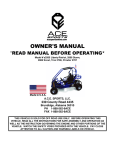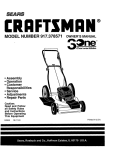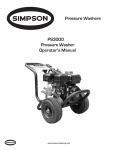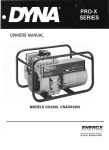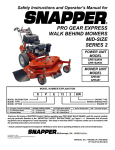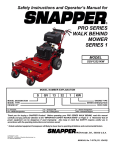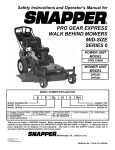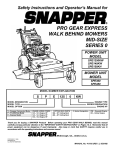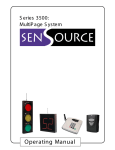Download Ace Sports 2585 Liberty Owner`s manual
Transcript
* ! A.C.E. SPORTS, LLC. 239 County Road 4435 Brundidge, Alabama 36010 PH 1-888-562-9ACE FAX 1-888-562-8ACE THIS VEHICLE IS SOLD FOR OFF ROAD USE ONLY. BEFORE OPERATING THIS VEHICLE, READ ALL THE INSTRUCTIONS FOR SAFE ASSEMBLY AND OPERATION AS WELL AS THE INSTRUCTION GOVERNING THE ENGINE AND OTHER PORTIONS OF THE VEHICLE. WATCH THE SAFETY VIDEO PROVIDED WITH THE VEHICLE. PAY CLOSE ATTENTION TO ALL CAUTION AND WARNING LABELS ON VEHICLE. IMPORTANT RULES FOR SAFE OPERATION NOTE: All the below items (1-34) should be read and understood by the operator. Failure to do so could endanger the personal safety of the operator and any passenger. 1. This v ehicle is not licensable. IT IS NOT TO BE OPERATED ON ANY PUBLIC ROAD, STREET, HIGHWAY , PARKING LOT, SIDEWALK, OR ALLEY . To do so would be in v iolation of local law. This v ehicle may be operated only on priv ate property and upon areas approv ed by local law. Av oid operating this v ehicle in any area with stationary objects that the v ehicle could trav el under. Do not ride in areas where other recreational v ehicles are being operated. Be respectf ul of landowners and the env ironment. 2. This v ehicle should NEVER be operated indoors. The exhaust f rom the engine contains carbon monoxide, which is a tasteless, odorless, and poisonous gas. 3. Unless otherwise specif ied in this manual, all screws, nuts, and bolts must be kept tight to ensure that the v ehicle is in saf e operating condition. The engine must be kept f ree of all dirt and other accumulations, pay ing particular attention to throttle linkage area. 4. Prev ailing-Torque-ty pe locknuts lose their locking capability with repeated use and require replacement. Ensure locknuts are f unctioning properly . 5. The tire pressure should be checked prior to each use. The recommended inf lation pressure is the maximum tire pressure as printed on the tire's sidewall. IMPROPER TIRE PRESSURE MAY CAUSE INSTABILITY AND MAY PREVENT PROPER BRAKING OR STEERING. 6. Modif ication of this v ehicle or remov al of any original equipment or saf ety decals may render the v ehicle unsaf e or illegal. NEVER REMOVE ANY CHAIN GUARD, BELT CLUTCH GUARD, TORQUE CONVERTER GUARD, OR JACK SHAFT GUARD. These cov ers are f or operator/passenger’s protection. If any guards are remov ed f or maintenance or serv icing of the v ehicle, ensure that they are secured in place prior to operating the v ehicle. 7. THE VEHICLE SHOULD NEVER BE STARTED WITHOUT FIRST CHECKING TO SEE THAT THE THROTTLE IS IN IDLE POSITION. Do not start engine without v erif y ing proper f unction of the throttle. Nev er attempt to start this v ehicle without hav ing the operator seated in the proper position or the f ront of the v ehicle against a stationary object. When starting with the operator in the seat, the operator should hav e their lef t f oot on the brake. The gas pedal on the right may be used to assist in maintaining RPM during a cold start. 8. 9. This v ehicle is not designed or intended f or racing, any f orm of competition, or use on rental tracks. The operator's ability to operate this of f -road v ehicle saf ely is largely dependent upon the operator's ability to exercise proper judgment. An operator also must not be too small or too large f or controlled operation. The operator must be of suf f icient age, understanding, mental capacity , and phy sical capability to saf ely operate this v ehicle. This v ehicle should only be operated af ter mature, superv ised instruction and suf f icient practice in decongested areas. Saf e operation includes responsibility f or the saf ety of a passenger (if any ). 10. A SINGLE SEAT VEHICLE IS DESIGNED FOR ONE OPERATOR ONLY. A DOUBLE SEAT VEHICLE IS DESIGNED FOR ONE OPERATOR AND ONE PASSENGER. No one should ev er attempt to ride on this v ehicle without being seated, with the seat belt properly secured. For double seat v ehicles riden without a passenger, the passenger seat belt must be secure to prev ent it f rom getting caught up in operating components. Any passenger must be of suf f icient age, understanding, mental capacity , and phy sical capability to act to protect himself /herself . 11. The engine should be stopped when the v ehicle is not in use. 12. The operator and passenger (if any ) of this v ehicle should alway s wear a helmet approv ed by agencies such as the Department of Transportation (DOT), Saf ety Helmet Council of America (SHCA), or Snell Memorial Foundation (SNELL). Most of f -road v ehicle accident f atalities are due to head injuries. The operator should also wear f ace shields or goggles, boots or closed-toe shoes, glov es, and other appropriate protectiv e clothing. 13. LOOSE CLOTHING, LONG HAIR, OR ARTICLES WORN BY ANY OPERATOR OR PASSENGER MUST BE FULLY CONTAINED, OR COVERED TO PREVENT THEM FROM POSSIBLY BEING CAUGHT IN ROTATING PARTS OF THE VEHICLE OR THE SURROUNDING ENVIRONMENT WHILE RIDING. FAILURE TO OBEY COULD ENDANGER THE PERSONAL SAFETY OF THE OPERATOR OR PASSENGER. 14. DO NOT PLACE HANDS, FEET, OR ANY OTHER PART OF THE BODY OR ANY CLOTHING NEAR THE ENGINE, MUFFLER, WHEELS, CHAIN, AND OTHER ROTATING PARTS OF THE VEHICLE WHILE RIDING OR RUNNING THE ENGINE. Caution must be used in perf orming required maintenance on or near an operating engine. Special caution should be taken af ter the engine has been running, since the engine and other driv e components may be extremely hot. 15. Wet, slippery , rough, or steep terrain is potentially dangerous and may result in injury if proper caution is not observ ed. Slow speeds are required to saf ely operate this v ehicle under those conditions. The operator must use mature judgment, skill, and experience to choose a speed suitable f or the terrain and riding conditions. 16. The gov ernor settings f or this v ehicle's engine must not be tampered with, altered, or changed. The gov ernor is set by the engine manuf acturer and limits the maximum speed of the engine (and v ehicle) and protects the engine f rom damage. Excessiv e speeds are potentially dangerous to the operator and the engine. 17. 18. 19. Each time bef ore using this v ehicle, the f uel supply should be checked. The f uel tank should nev er be f illed while the engine is running or while the engine is hot. Do not f ill tank in a closed area such as a garage, while smoking, or in the v icinity of an open f lame. Do not ov erf ill the tank. Alway s f ollow the directions in the engine owner’s manual. There should not be any f uel in the f iller neck. Replace cap tightly to prev ent spillage of f uel and potential f ire hazard. Af ter f illing tank, mov e the v ehicle at least 15 f eet away f rom spot of f illing bef ore starting. If the v ehicle should start making unusual noise or v ibrating abnormally , the engine should be stopped and the spark plug wire disconnected. The v ehicle should then be checked f or damage. Excessiv e noise or v ibration is generally a warning of loose or worn parts. When making repairs or adjustments to the v ehicle which do not inv olv e adjustments to the engine, the spark plug wire must be disconnected and kept away f rom the spark plug to prev ent accidental starting. When working on or around, or when restarting engine, use extreme caution to av oid contact with the muf f ler, cy linder head, or any other potentially hot area on or around the engine. 20. Alway s perf orm a Pre-Ride Inspection bef ore starting the engine. See Pre-Ride Inspection section in this manual. 21. The Custom Bar Cage assembly prov ided with this v ehicle is not designed as a “roll bar”. Do not operate this v ehicle without the cage properly installed. Vehicles with light kits are f or decorativ e purposes and to assist others in seeing y ou. Only operate this v ehicle during day light. 22. When storing the v ehicle, it must be kept in a place where gasoline f umes will not reach an open f lame or spark. For long period of storage, such as f or winter, the f uel tank should be drained in an open, cool area. The engine must be allowed to cool bef ore storage in any enclosure. Read and keep all printed material supplied with this v ehicle. Timely and specif ic instructions and a Operator's Manual rev isions are included in supplements. If any printed material included is unclear, contact y our dealer/ retailer f or assistance. 23. NEVER OPERATE THIS VEHICLE WHILE UNDER THE INFLUENCE OF ALCOHOL, DRUGS, OR MEDICATION OF ANY KIND. SUCH OPERATION COULD BE DANGEROUS TO Y OURSELF AND/OR OTHERS. 24. Alway s slow down when turning. High speed turning may cause loss of control, possible turnov er of the v ehicle, and/or possible injury to operator or passenger. 25. When turning on pav ement, knobby tires may increase the risk of loss of control. ALWAY S SLOW DOWN! 26. DO NOT RACE, JUMP, PERFORM “STUNT” RIDING OR “SPINOUTS” WHEN OPERATING THIS VEHICLE. THIS VEHICLE IS NOT DESIGNED OR INTENDED FOR SUCH OPERATION. 27. This manual, along with the other supplements prov ided with y our v ehicle, prov ide guidelines f or the assembly , maintenance, and operation of this v ehicle and is not intended as a serv ice manual. 28. Assembly , maintenance, and/or repair of this v ehicle should only be perf ormed by persons of suf f icient mechanical skill, experience, and judgment (such as outdoor equipment dealers, motorcy cle dealer/shops, or small engine dealers) so that no unsaf e condition or modif ication is made. 29. Alway s use extreme caution when starting the engine. Av oid touching the engine, muf f ler, or 30. 31. driv e components. These areas could cause burns on contact. 32. The battery (if applicable) contains sulf uric acid and must not come in contact with skin, ey es, or clothing since this will cause sev ere burns possibly causing disf igurement. Also, battery may generate explosiv e gases and must not be exposed to sparks, f lame, cigarettes, or any thing f lammable or an explosion may result causing sev ere injury . Operating this v ehicle requires skills acquired through practice ov er a period of time. Take the time to learn the basic techniques well bef ore attempting to operate the v ehicle. 33. Operate only on saf e and f amiliar terrain. Av oid loose grav el and rocks. Be caref ul on wet surf aces and allow f or extra braking distance. 34. ALWAY S mount the caution f lag prov ided on the v ehicle f or saf ety purposes. OPERATOR MUST ALWAY S BE APPROPRIATELY SUPERVISED AT ALL TIMES WHILE OPERATING THE VEHICLE. % " &$ $ ' " #$ ()' ( ' * + #( , WARNINGS are procedures that if not followed could result in serious injury or death. CAUTIONS are procedures to prevent damage to the vehicle or injury. NOTES Highlight important information. Read each carefully! PAY CLOSE ATTENTION TO ALL CAUTION AND WARNING LABELS ON THE VEHICLE. THIS VEHICLE IS SOLD FOR OFF ROAD USE ONLY. BEFORE OPERATING THIS VEHICLE, READ ALL THE INSTRUCTIONS FOR SAFE ASSEMBLY AND OPERATION AS WELL AS THE INSTRUCTION GOVERNING THE ENGINE AND OTHER PORTIONS OF THE VEHICLE. WARNING: The Engine Exhaust from this product contains chemicals known to the State of California to cause cancer, birth defects, or other reproductive harm. 1. Steering Wheel - Bolt steering wheel to anchor plate securely with the f asteners. 2. Seat - Bolt seat to v ehicle f rame. Adjust seat f or operator. Then, install the seat cushion, if it is separate. 3. Bolts - Check the screws, nuts, and bolts on y our v ehicle to see that all are tightened securely . For saf e operating conditions, do periodic checks and tighten securely . 4. Engine - Fill the crankcase with oil as directed in the engine owner’s manual prov ided. cautions, and procedures contained in that manual. 5. Custom Bar Cage (CBC) - Assemble the CBC (and light kit, if prov ided) using the instructions prov ided in the CBC box. 6. WARNING—Tire Pressure – The air pressure in each tire should be checked caref ully . The proper air pressure f or each ty pe of tire is printed on the the side of the tire. Some v ehicles with dif f erent tires on the f ront and rear may also hav e dif f erent air pressures. Ensure each tire is properly inf lated. Tires that are under or ov erinf lated can create dangerous conditions that could result in loss of control and serious injury or death. Follow all warnings, WARNING - Perform this pre-ride inspection prior to operating the v ehicle. If not performed, serious damage to the v ehicle or personal inj ury may result. 1. ENGINE OIL LEVEL - Add oil if required. Check for leaks. Tighten filler cap securely. 2. FUEL LEVEL - Add fuel as necessary. Do not overfill (no fuel in the filler neck). Replace cap tightly. Check for leaks. Do not mix oil with gas. WARNING - Do not refill engine while it is hot. It is possible for spilled fuel to ignite resulting in a fire. Do not fill gas tank in a closed area such as a garage. After filling the tank move the vehicle at least 15 feet away from spot of filling before starting. 3. BRAKES - PERFORM A BRAKE TEST: Have the operator sit in the seat, then push the vehicle from behind. Once the vehicle is rolling, have the operator apply the brake pedal. The vehicle should come to a stop. WARNING- Do not operate this vehicle unless the brake is working properly. NOTE: Band brake systems typically require a short break-in period to operate at full efficiency. Some wear on the lining of the brake pads will increase the coefficient of friction and improve their effectiveness. That can be accomplished by making a series of gentle stops. Hard usage of the brakes without a break-in period can result in shortened brake pad life and decrease braking ability. 4. TIRES - Check condition and pressure. 5. DRIVE CHAIN - Check condition, tension, lubricate as necessary. 6. THROTTLE - CHECK FOR SMOOTH OPERATION. Assure throttle "snaps" back to idle. Also, check for frayed cable or damaged cable conduit. If either condition exists replace the cable assembly before riding. 7. TOGGLE KILL SW ITCH - PERFORM THIS TEST (only for models without electric starter): While the engine is running, move the toggle kill switch on the steerring column to the "OFF" position. If this does not stop the engine, check to ensure that the toggle kill switch wire is attached to the terminal on the engine. WARNINGDO NOT OPERATE THIS VEHICLE WITH A TOGGLE KILL SWITCH THAT IS NOT FUNCTIONING PROPERLY. 8. ALL NUTS, BOLTS, AND FASTENERS - Check wheels to see that all axle nuts and lug nuts are tightened properly. Check and tighten all other fasteners as necessary. 9. GUARDS - Ensure all protective guards are in place. NEVER OPERATE THIS VEHICLE WITHOUT ALL CHAIN, CLUTCH, OR DRIVE ASSEMBLY COVER GUARDS IN PLACE. Each of these covers have a protective purpose, if removed, could endanger the personal safety of the operator or passenger (if any). 10. STEERING SYSTEM - Ensure that it turns freely. CORRECT any discrepancies according to the Ow ner's Manual before riding. If a problem cannot be corrected, contact an authorized dealer/retailer for assistance . NOTE: Do not attempt to start or operate this machine w ithout being completely familiar w ith all controls necessary to operate this v ehicle safely. Do not start the engine before reading and understanding all the rules, w arnings, and instructions in this manual, as w ell as the engine ow ner’s manual. We strongly recommend that all superv isors, operators and passengers v eiw the safety v ideo prior to operation. TURNING MANEUVERS ground. If the front wheels lift, the operator’s control will be lessened and the vehicle may overturn backwards. A new operator must learn to shift his or her weight and control the throttle to allow the rear tires to negotiate the turn. This is the primary technique to be mastered in riding this vehicle. Practice turning at slow, constant speeds. Defer increased speeds until you are confident of your proficiency and are intimately familiar with the terrain. If you should find that you have incorrectly estimated climbing capability and lack the power or traction to continue the ascent, if space permits, turn the vehicle around while you still have the forward speed to do so and descend. Avoid stalling part way up a hill, as maneuvering will then become more difficult. Steer in the direction of the turn, and lean your body to the inside of the turn in order to maximize front tire traction. Use the throttle to maintain power throughout the turn. CAUTION - Before attempting a turn on a hillside, the operator should first master turning technique on level ground. Once this technique is learned, turning maneuvers can be performed within a relatively small area. Incorrect turning techniques may cause the front wheels to slide straight ahead without affecting the vehicle's direction of travel. If this should occur, come to a stop, then resume the technique outlined above. If the front wheels tend to skid in mud, sand, or snow, you may be able to improve control by releasing the throttle and allowing the vehicle to coast through the turn. If the rear wheels inadvertently skid sideways, correct your slide by steering in the direction of the skid, if you have room to perform this maneuver safely. Avoid braking or accelerating until you have control. To avoid skids while traveling on slippery terrain, the operator must exercise a high degree of caution. Turning maneuvers on slippery terrain are more hazardous than those performed under full traction and must be done slowly. Surface composition is a major factor affecting skidding. It is easier to slide on packed snow than in deep sand. It is dangerous to skid on ice, because you may lose all directional control, and it is dangerous to skid on pavement, because you may regain traction suddenly and unexpectedly, which can cause the vehicle to overturn. CLIMBING HILLS If you do lose all forward speed, and can neither continue uphill nor maneuver the vehicle under its own power, turn off the engine, dismount, and physically turn the machine around. CAUTION - To avoid overturning, the operator must exercise a high degree of caution when dismounting or moving this vehicle on a hillside. DESCENDING HILLS It is usually advisable to descend hills with the vehicle pointed directly downhill, avoiding angles that would cause the vehicle to lean sharply to one side. As you approach the point of descent, stop and survey the terrain below. Never drive headlong past your limit of visibility. When you have picked a safe path of descent, descend slowly with the throttle closed. Sit back on the seat, with arms extended and braced on the steering wheel. When descending it is recommended that the operator apply the brakes intermittently to further reduce forward speed. Braking effectiveness is reduced while descending any incline with a loose surface. RIDING THROUGH W ATER Do not cross any stream with fast flowing water. The tires may float, making it difficult to maintain control. Do not drive the vehicle through water for prolonged periods. Practice climbing on evenly surfaced slopes of less than 20 degrees. The vehicle's capability in climbing hills or traversing any specific terrain is dependent upon operator skill and vehicle load. As you gain experience in handling this vehicle, and learn the hazards to be encountered and your own limitations you may then proceed to drive more challenging terrain. However, you must first be able to discern and avoid any hill or hazard that would cause this vehicle to overturn. The vehicle can cross water to a depth of approximately 4-6 inches, although the operator must be careful to avoid getting the spark plug or air cleaner wet. Take a running start, at the appropriate speed for the ascent, and climb at a steady rate of speed. If loss of forward motion or pulling power is noticed when driving through water, it indicates the torque converter belt has become wet. When this occurs, the operator should immediately head toward shore at minimum throttle required to maintain motion. Once on shore, the WARNING - Do not apply power suddenly by opening the throttle while ascending a hill or the front wheels may rise from the When crossing shallow streams, choose a course where both banks have gradual inclines. Proceed at a slow, steady speed, and take care to avoid submerged obstacles and slippery rocks. torque converter belt will dry quickly if operator will sit for a few moments with the engine idling. necessary, apply the brakes repeatedly until the heat of friction has dried them and the brakes retain their normal effectiveness. After driving through water, the brakes may be less effective than normal. Test the brakes after traveling through any water, and if WARNING - Do not operate vehicle at high speeds until brakes are dry and effective. STORAGE In the event your vehicle is not to be operated for a period in excess of 30 days and at the end of each riding season prepare for storage as follows: WARNING - Do not drain fuel while engine is hot. Be sure to move vehicle outside before draining fuel. 1. Drain fuel tank and remove all fuel remaining in the tank by using a suction device or by soaking up with a clean rag or towel. Remove all fuel remaining in the carburetor by allowing engine to run out of fuel. Do not perform any fuel removal procedure while smoking or near an open flame. Dispose of any rags or towels properly. 2. Lubricate engine cylinder by removing the spark plug and pouring one ounce of clean lubricating oil through the spark plug hole into the cylinder. Crank the engine slowly to spread oil and replace spark plug. 3. Do not save or store gasoline over winter. Using old gasoline which has deteriorated from storage will cause hard starting and affect engine performance. 4. Monthly charging of the battery (if applicable) is recommended in the off-season. WARNING - Battery may generate explosive gases after filled with acid and during charging or use. Keep sparks, flame, cigarettes, or anything flammable away. Ventilate when charging or using battery in an enclosed space, and ensure that the battery vent path is always open. 5. When the vehicle is removed from storage re-read the owner's manual, perform any assembly required, and perform a pre-ride inspection. See PreRide Inspection section of this manual. GENERAL Just as your automobile needs professional, mechanical maintenance from time to time, so does this vehicle. Replacement of the spark plug and ignition points is made necessary by normal use. Professional air cooled engine service is easily obtained. Check your phone book yellow pages under "EnginesGasoline." ENGINE LUBRICATION – Ensure that you follow the procedures outlined in the engine owner’s manual that is provided as a supplement to this manual. Failure to follow procedures could reduce the life of your engine. VEHICLE LUBRICATION - Every two or three hours of use lubricate the following items with several drops of oil; steering bearing points, brake rod pivot points, pedal pivot points, steering spindles, and steering rod ends. Use the same grade of lubricating oil that is used in the engine crankcase. CHAIN LUBRICATION - For the best chain life, it should be lubricated with a graphite type lubricant such as the spray-on type which evaporates leaving the graphite on the chain. Using oil or grease on the chain in dusty or sandy riding conditions may cause dirt particles to stick to the chain resulting in rapid wear from abrasion. TORQUE CONVERTER LUBRICATION - Although the Torque Converter has been designed for many hours of use, periodic cleaning and lubrication is necessary for optimum life and performance. Extremely dust, dry climates would require more frequent maintenance checks. Here are the steps to take to maintain the Torque Converter: Examine the sheaves surfaces of both the front and rear unit. Clean all dust, dirt and belt residue from surfaces. This must be done with an evaporative solvent. The belt and belt surfaces must be free of dirt and grease. Remove the cover from the front drive unit. Clean all dust and dirt from internal parts, and re-lubricate with a dry lubricant such as molybdenum disulfide. Reassemble unit and be sure cover is securely replaced. CENTRIFUGAL CLUTCH LUBRICATION - There are two main elements that can shorten the life of a clutch - poor lubrication and dirt/sand. The clutch contains an oil-impregnated bronze bushing (part '3' on illustration). It is press fitted inside on the sprocket and surrounds a steel sleeve onto which a snap ring clips. The small snap ring at the end of the sprocket holds the clutch together, and for this reason the snap ring should not be removed. With the engine off, apply oil (SAE 30 motor oil) to the snap ring area. (See illustration 2 for details.) To make it easier for the oil to work its way into the bushing area, try to manually roll the vehicle along while applying the oil. If you lift the rear end and support it on the frame you can rotate the rear wheels to work the oil into the bushing. Never apply grease to this bushing, because it clogs the pores and retards proper lubrication. For best results, oil every two hours of running time. (4 or 5 drops). Dirt and sand are abrasive and can act like sandpaper to prematurely wear the bushing, the sprocket, the chain, and other parts of your vehicle. Since these vehicles are driven on all kinds of terrain, it's often Illustration 2 hard to keep the moving parts dirt free. A clean vehicle can prolong the life of the clutch's bushing and sprocket as well as the chain and other bearings on the vehicle. Try wiping or brushing away as much dirt as possible from these areas after each use. If you find that the drum and sprocket assembly wobbles on the steel sleeve, this is an indication of a worn bushing. You should get a new clutch or replacement bushing. A worn bushing can lead to a thrown chain. Replacing the bushing early when you first see the excessive wear will prevent the sleeve from becoming worn and damaged. FRONT W HEEL REPLACEMENT - Care must be used when replacing wheels. DO NOT OVER-TIGHTEN AXLE NUTS. It is only necessary to tighten the nuts so that the wheel turns freely on the axle with minimum end play. If the wheel does not turn freely the nut is too tight. REAR W HEEL REPLACEMENT - Loosen the large locknut in the center of the wheel to remove the rear wheel. Illustration 1 CHAIN ADJUSTMENT - After the first two hours of operation, check the chain adjustment and readjust it if it has more than 3/8" flex. Loosen the engine clamp nuts and slide the engine and jack shaft assembly rearward to tighten the chain. Allow about 3/8" flex for proper adjustment. Tighten the nuts securely. On models equipped with a centrifugal clutch, the engine may need to be moved forward to tighten the chain. RECORD THE MODEL NUMBER AND SERIAL NUMBER OF YOUR VEHICLE IN SPACES PROVIDED BELOW FOR REFERENCE WHEN ORDERING REPLACEMENT PARTS. Model No. _________________________________________________ Color _______________ Serial #_______________________________________________________________________________ (red and silver tag attached to go-kart frame) A.C.E. Sports Power Sports Warranty Information 1-866-816-5060 Warranty Protect provides Manufacturers and Distributors in North America with world-class warranty servicing and underwriting. WP builds customized warranty programs and web-interfaces for its customers, utilizing 24/7 x 365 day call center coverage across nearly 1,000 agents in 22 locations. Recent call center awards include: 2006 – Contact Center W orld’s Best in the World Award for Best Technology Innovation; 2004 - One of Inc 500 fastest growing companies; 2003 - Member’s Choice Award for best outsourcing services; and 2002 – Users Choice Award’s Best-In-Class winner. WP’s customized claim servicing and service provider locator allow our customers to offer warranty services to the consumer in a seamless manner. In addition, Warranty Protect has the ability to tow any on-road Power Sports unit to the service facility through it own roadside assistance dispatch system in the US, Canada and Puerto Rico. The Warranty Group’s proprietary approach to administering service plans delivers benchmark satisfaction – for your customers and your balance sheet. With trained product experts and systematic trend analysis, claims are adjudicated quickly utilizing innovative technology. Warranty Protect adds value through: Peace of mind– no out of pocket expense to the consumer for repair costs on covered items. Convenience– we provide pick-up and delivery of the disabled vehicle ( 50 mile limit ) to one of our local professional network technicians through our national towing network or if you prefer you may deliver it in person. Technology - by utilizing state-of-the-art technology to assure service exceeds customer expectations. Limited Warranty Coverage - 6 months (180 days) from date of purchase WP coverage includes parts, labor and roadside assistance, if needed, for your registered A.C.E. Sports product. This is a zero deductible plan that insures you the best service after the sale. Items Not Covered – Wearable parts such as tires, belts, hoses, bulbs, sprockets, chains, clutches; throttle cable, brake cable, seat, fasteners, air filters, brake pads, oil changes & any item that has been abused, neglected OR used in a manner for which it is not designed. Modifications to your product that are not A.C.E. Sports approved will void the warranty. Defective parts are subject to recall by Warranty Protect and / or A.C.E. Sports upon failure and are required to be held by the service center until the warranty claim is settled. Our go karts, atv’s & buggies are designed for off-road use only. How To Register My Product – Complete the warranty registration form and fax to 1-888-562-8223 or mail to: Warranty Protect Registration 239 County Road 4435 Brundidge, Al. 36010. Product must be registered within 10 days of purchase. It is the little things that matter most when operating a top level W arranty Program. W hen dealing with Warranty Protect you can rest assured we are always looking to provide the best service possible to the customer! As our slogan says: “Providing the Peace of Mind You Expect!” A.C.E. Sports is the ONLY manufacturer to provide such a great plan! Warranty Protect Service Center Locator – to locate a Warranty Protect Service Center for your A.C.E. Sports power sports product, please call 1-866-816-5060 to speak to a Warranty Protect representative or view http://www.warrantyprotect.com/dealer_database/dealer-locator.asp A.C.E. Spo rts, LLC 239 Co unty Road 4435 Bru ndidge, Al. 36010 – info@acesp ortso nline.com










